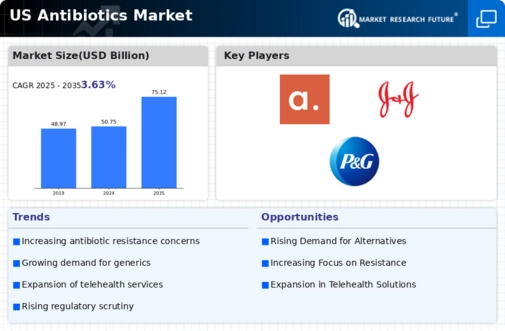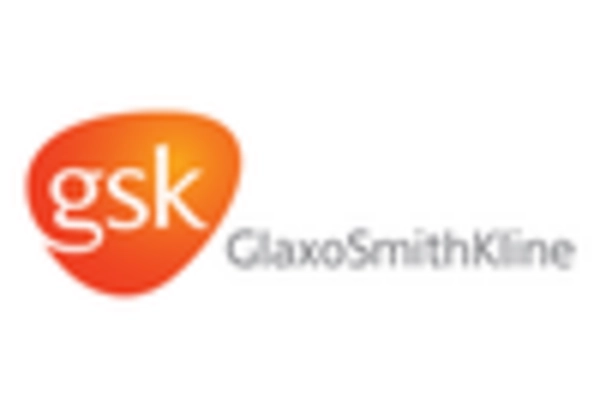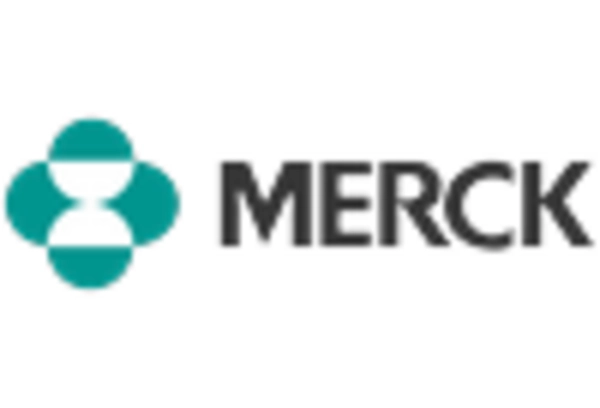Government Initiatives and Funding
Government initiatives and funding play a crucial role in shaping the antibiotics market. The US government has recognized the urgent need to address antibiotic resistance and has allocated substantial resources to support research and development in this area. Programs such as the National Action Plan for Combating Antibiotic-Resistant Bacteria (CARB) aim to foster innovation and collaboration among public and private sectors. This financial backing not only incentivizes pharmaceutical companies to invest in antibiotic research but also enhances the overall market landscape. As a result, the antibiotics market is expected to experience a boost, with funding initiatives potentially increasing the market size by 6% over the next few years.
Rising Awareness of Antibiotic Stewardship
Rising awareness of antibiotic stewardship programs is driving the antibiotics market in the US. These programs aim to optimize the use of antibiotics to combat resistance and improve patient outcomes. Healthcare institutions are increasingly implementing guidelines to ensure appropriate prescribing practices, which may lead to a more judicious use of existing antibiotics. This shift not only helps in preserving the efficacy of current antibiotics but also encourages the development of new agents. The antibiotics market is likely to see a shift in demand towards more effective and targeted therapies, as healthcare providers become more educated about the implications of antibiotic misuse. This trend could result in a market growth of approximately 3% annually.
Increasing Incidence of Infectious Diseases
The rising incidence of infectious diseases in the US is a primary driver for the antibiotics market. As bacterial infections become more prevalent, healthcare providers increasingly rely on antibiotics for treatment. According to the Centers for Disease Control and Prevention (CDC), antibiotic-resistant infections affect over 2 million people annually in the US, leading to significant morbidity and mortality. This alarming trend necessitates the development and use of effective antibiotics, thereby propelling market growth. The antibiotics market is projected to reach approximately $50 billion by 2026, reflecting a compound annual growth rate (CAGR) of around 4.5%. This growth is indicative of the urgent need for innovative antibiotic therapies to combat the rising tide of infectious diseases.
Technological Advancements in Drug Development
Technological advancements in drug development are significantly influencing the antibiotics market. Innovations such as artificial intelligence and machine learning are streamlining the drug discovery process, enabling faster identification of potential antibiotic candidates. These technologies facilitate the analysis of vast datasets, which can lead to the discovery of novel compounds that may be effective against resistant bacteria. Furthermore, the integration of advanced biotechnological methods is enhancing the efficiency of clinical trials, potentially reducing the time to market for new antibiotics. As a result, the antibiotics market is expected to benefit from these advancements, with an estimated growth rate of 5% annually over the next five years.
Growing Demand for Probiotics and Alternative Therapies
The growing demand for probiotics and alternative therapies is influencing the antibiotics market. As consumers become more health-conscious, there is an increasing interest in natural remedies and preventive healthcare. Probiotics, which are beneficial bacteria, are gaining popularity as a means to support gut health and enhance the immune system. This trend may lead to a shift in consumer preferences away from traditional antibiotics towards alternative treatments. However, this does not diminish the need for antibiotics; rather, it suggests a more integrated approach to health management. The antibiotics market may see a diversification of products, with an estimated growth of 4% annually as companies adapt to changing consumer demands.

















Leave a Comment